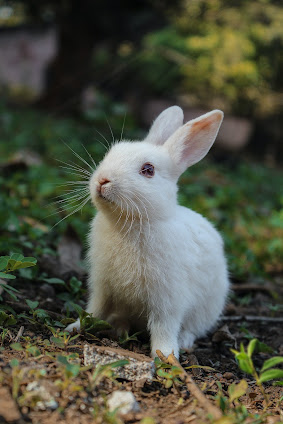INTERESTING FACTS:
• Males mark their territory with farces or by exudates from glands located under their chin.
• Females can have up to 5 litters a season (average of 3-4 kittens per litter).
• Gestation period is 26-30 days.
• Kittens are blind and have no fur at birth but they can see and have fur by 10 days of age.
• Kittens suckle from their mother for the first few weeks.
• Rabbits live an average of 5 years.
• Rabbits hop on their hind legs using the front legs to balance.
• They can travel as fast as 29 kilometers per hour.
• Rabbits have sensitive hearing and a keen sense of smell – nose is twitching all the time.
• Rabbits eyes are on the side of their face so that they see better to the side and behind.
• Rabbits have chisel-like front teeth and a 5cm fluffy tail.
• Rabbits rarely need to drink water if the moisture content of the food is high enough.
DIGESTIVE PROCESS OF RABBITS:
An interesting feature of a rabbit’s digestive process is the re-ingestion of a special soft type of pellet directly from the anus – the pellet being formed by bacterial ferment – action in the cesium (lower bowel) and containing assimilable (readily digestible) food and B-group vitamins. This process is known as Coprophagy.
ORIGIN OF RABBITS:
It is believed that the rabbit originally came from Northern France as it is similar to a Flemish word meaning “rabbit”. In the 18th century in England, rabbits were called a “Coney”, “conie” or “cony”.
RABBITS are pests:
Rabbits are considered pests. Liberation of rabbits into the wild is illegal. Poisoning, spraying, trapping and shooting rabbits are legal, and landholders are responsible for destroying rabbits on their property (Rural Lands Protection Act 1985).
Rabbits have caused millions of dollars of damage to crops and animal life. Seven to ten rabbits eat the equivalent of one adult sheep, and, during drought periods, rabbits can totally strip a landscape bare leaving no food for sheep, cattle or native animals. This loss of vegetation leads to soil erosion as the exposed soil is washed or blown away, removing valuable soil nutrients that is required for new plants to develop. Then the soil is typically deposited in waterways, causing siltation and destroying aquatic ecosystems.
Various methods in the 20th century have been attempted to control the population.
Conventional methods include shooting and destruction of warrens, but these had only limited success. In 1907, a rabbit-proof fence was built in Western Australia in an attempt to contain the rabbits. Eventually the myxoma virus, which causes myxomatosis, was introduced into the rabbit population in the 1950s, and this greatly reduced the rabbit population.
However, although the rabbit is a notorious pest, it proved helpful to many people during the Great Depression and during wartime. People trapped rabbits for food and sold them for extra income. Not only were rabbits eaten by people but also they were fed to working dogs, and boiled for poultry feed. Later, frozen rabbit carcasses were traded locally and exported. Pelts, too, were used in the fur trade and are still used in the felt hat industry.
BREEDS:
PERMITS are required to keep a rabbit in Queensland and are not available to
the General Public or Animal Farms in Queensland Breeds are characterized by size, shape, ears, fur texture, sheen, and colour. In some breeds, the individual fur characteristics are combined. Some of the most common rabbit breeds in Australia are the Dwarf Lop, Mini Lop, Rex, Dutch and Satin. Photos & descriptions can be found on web sites like: www.rabbitempire.org/breeds-of-rabbits Lop refers to rabbits that have drooped ears although they are usually upright when they are born and droop as they get older. Lop rabbits have thick, soft velvety fur which is a delight to touch. The distinction between a dwarf rabbit and a mini rabbit is weight. A mini lop is no heavier than 1.6kg, while a dwarf can reach 2.5 kg. Dwarf and Lop rabbits have only been in Australia since 1998 but they have been extremely popular since their introduction.
Rex refers to the gene which makes hair thin, sparse and curly. The Rex is around 3kg in weight and is a medium sized rabbit. Dutch rabbits are highly recommended for families with children as these docile and hardy rabbits love lots of attention. Satin rabbits are an average sized rabbit with a distinctive coat. They have translucent hairs which give the coat a satin sheen. Although satin rabbits are widely used for their fur commercially these rabbits are also a popular family pet.
RABBIT PRODUCTS / USES:
• SKINS - used to make fur coats and bags, and the trimmings on coats and hats, (4 rabbits
are needed per 1 hat). The skins are sometimes dyed to look more like expensive fur,
such as mink.
• FELTS are also used for making soft toys. The rabbit’s fur is generally combined with
other furs by squeezing them together.
• MEAT PRODUCTS - Rabbit meat is leaner than beef, pork, and chicken meat.


Comments
Post a Comment